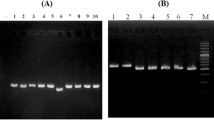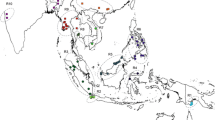Abstract
Phylogenetic relationship between O. malampuzhaensis Krish. et Chand. (2n = 4x = 48; Poaceae, Oryzeae), a South Indian endemic wild rice with a disputed taxonomic identity, and eight other species belonging to the O. officinalis complex of the genus Oryza was examined using 62 morphological characters and 445 random amplified polymorphic DNA (RAPD) markers. Multivariate and cluster analyses using both the data sets clearly separated all accessions of O. malampuzhaensis into a distinct group. Genetic distances between O. malampuzhaensis and other species in O. officinalis complex were comparable with the distance between any other two taxa with species rank in this complex. Case-by-case taxonomic treatment of O. malampuzhaensis in relation to other species examined is presented. A taxonomic key for the discrimination of O. malampuzhaensis from other species in the O. officinalis complex has been constructed. Based on the present results, we strongly argue to restore the species rank to O. malampuzhaensis, as originally proposed by Krishnaswamy and Chandrasekharan (1958).
Similar content being viewed by others
References
Aggarwal RK, Brar DS, Nandi S, Huang N, Khush GS (1999) Phylogenetic relationships among Oryza species revealed by AFLP markers. Theor Appl Genet 98: 1320–1328
Bao Y, Lu B-R, Ge S (2005) Identification of genomic constitution of Oryza species with the B and C genomes by the PCR-RFLP method. Genet Resour Crop Evol 52: 69–76
Barreneche T, Bodenes C, Lexer C, Trontin J-F, Fluch S, Streiff R, Plomion C, Roussel G, Steinkellner H, Burg K, Favre J-M, Glossl J, Kremer A (1998) A genetic linkage map of Quercus robur L. (pedunculate oak) based on RAPD, SCAR, microsatellite, minisatellite, isozyme and 5S rDNA markers. Theor Appl Genet 97: 1090–1103
Baum BR, Yang J-L, Yen C (1995) Taxonomic separation of Kengyilia (Poaceae: Triticeae) in relation to nearest related Roegneria, Elymus and Agropyron based on some morphological characters. Plant Syst Evol 194: 123–132
Bautista NS, Vaughan DA, Jayasuriya AHM, Liyanage ASU, Kaga A, Tomooka N (2006) Genetic diversity in AA and CC genome Oryza species in southern South Asia. Genet Resour Crop Evol 53: 631–640
Buso GSC, Rangel PHN, Ferreira ME (2001) Analysis of random and specific sequences of nuclear and cytoplasmic DNA in diploid and tetraploid American wild rice species (Oryza spp.). Genome 44: 476–494
Casiva PV, Saidman BO, Vilardi JC, Cialdella AM (2002) First comparative phenetic studies of Argentinean species of Acacia (Fabaceae), using morphometric, isozymal and RAPD approaches. Am J Bot 89: 843–853
Castro S, Silveira P, Coutinho AP, Figueiredo E (2005) Systematic studies in Tylosema (Leguminosae). Bot J Linn Soc 147: 99–115
Chang TT (1988) Taxonomic key for identifying the 22 species in the genus Oryza. Int Rice Res Newsl 13: 4–5
Duncan T, Baum BR (1981) Numerical phenetics: Its uses in botanical systematics. Ann Rev Ecol Syst 12: 387–404
Federici MT, Shcherban AB, Capdevielle F, Francis M, Vaughan DA (2002) Analysis of genetic diversity in the Oryza officinalis complex. J Biotech 5: 173–181
Gallois A, Audran JC, Burrus M (1998) Assessment of genetic relationships and population discrimination among Fagus sylvatica L. by RAPD. Theor Appl Genet 97: 211–219
Ge S, Sang T, Lu B-R, Hong D-Y (1999) Phylogeny of rice genomes with emphasis on origins of allotetraploid species. Proc Natl Acd Sci USA 96: 14400–14405
Goldman DH, van den Berg C, Griffith MP (2004) Morphometric circumscription of species and infraspecific taxa in Calopogon R. Br. (Orchidaceae). Plant Syst Evol 247: 37–60
Gopalakrishnan R, Sharma SD, Shastry SVS (1965) Genome constitution of Oryza malmapuzhaensis Krish. et Chand. Curr Sci 34: 128
IRRI (1980) Descriptors for rice Oryza sativa L. International Rice Research Institute, Manila, Philippines
Joseph L, Kuriachan P, Kalyanaraman K (1999) Collection and evaluation of the tetraploid Oryza officinalis Wall ex Watt (O. malampuzhaensis Krish. et Chand.) endemic to Western Ghats, India. Genet Resour Crop Evol 46: 531–541
Joshi SP, Gupta VS, Aggarwal RK, Rajenkar PK, Brar DS (2000) Genetic diversity and phylogenetic relationship as revealed by inter simple sequence repeat (ISSR) polymorphism in the genus Oryza. Theor Appl Genet 100: 1311–1320
Kaushal P, Ravi, Sindhu JS (1998) Screening of wild Oryza species against bacterial leaf blight (Xanthomonas oryzae pv oryzae) pathotype of Punjab (India). Pl Breed 117: 49–493
Krishnaswamy N, Chandrasekharan P (1958) A new species of Oryza L. Madras Agr J 45: 471–472
Lakusic D, Conti F (2004) Asyneuma pichleri (Campanulaceae), a neglected species of the Balkan Peninsula. Plant Syst Evol 247: 23–36
Li C-B, Zhang D-M, Ge S, Lu B-R, Hong D-Y (2001) Identification of genome constitution of Oryza malampuzhaensis, O. minuta and O. punctata by multicolour genomic in situ hybridization. Theor Appl Genet 103: 204–211
Mudge J, Huihuang Y, Denny RL, Howe DK, Danesh D, Marek LF, Retzel E, Shoemaker RC, Young ND (2004) Soybean bacterial artificial chromosome contigs anchored with RFLPs: insights into genome duplication and gene clustering. Genome 47: 361–372
Nei M, Li WH (1979) Mathematical model for studying genetic variation in terms of restriction endonuclease. Proc Natl Acad Sci USA 74: 5269–5273
Nishikawa T, Vaughan DA, Kadowaki K (2005) Phylogenetic analysis of Oryza species, based on simple sequence repeats and their flanking nucleotide sequences from the mitochondria and chloroplast genomes. Theor Appl Genet 110: 696–705
Posto AL, Prather LA (2003) The evolutionary and taxonomic implications of RAPD data on the genetic relationships of Mimulus michiganensis (Comb. et Stat. Nov.: Scrophulariaceae). Syst Bot 28: 172–178
Roschevicz RJ (1931) A contribution to the knowledge of rice. Appl Bot Genet Plant Breed Bull 27: 2–133
Rossello JA, Cebrian MC, Mayol M (2002) Testing taxonomic and biogeographical relationships in a narrow mediterranean endemic complex (Hippocrepis balearica) using RAPD markers. Ann Bot 89: 321–327
Shcherban AB, Vaughan DA, Tomooka N, Kaga A (2001) Diversity in the integrase coding domain of a gypsy-like retrotransposon among wild relatives of rice in the Oryza officinalis complex. Genetica 110: 43–53
Second G (1985) New insight into the genome differentiation in Oryza L. through isozymic studies. In: Sharma A, Sharma A (eds) Advances in chromosome and cell genetics. Oxford and IBH Publishing Co., New Delhi, pp 45–78
Sharp PJ, Kreis M, Shewry PR, Gale MD (1988) Location of ß amylase sequences in wheat and its relatives. Theor Appl Genet 75: 286–290
Shipunov AB, Fay MF, Chase MW (2005) Evolution of Dactylorhiza baltica (Orchidaceae) in European Russia: evidence from molecular markers and morphology. Bot J Linn Soc 147: 257–274
Sneath PHA, Sokal RR (1973) Numerical taxonomy. W. H. Freeman and Company, San Francisco
Suh Y, Lee J, Lee S, Lee C, Yeau S-H, Lee NS (2002) Molecular evidence for the taxonomic identity of Korean Adonis (Ranunculaceae). J Plant Res 115: 217–223
Tateoka T (1962) Taxonomic studies of Oryza I. O. latifolia complex. Bot Mag Tokyo 75: 418–427
Tateoka T (1963) Taxonomic studies of Oryza III. Key to the species and their enumeration. Bot Mag Tokyo 76: 165–173
Thomas G, Sreejayan, Joseph L, Kuriachan P (2001a) Genetic variation and population structure in Oryza malampuzhaensis Krish. et Chand. endemic to Western ghats, South India. J Genet 80: 141–148
Thomas G, Joseph L, Varghese G, Sreejayan, Kalyanaraman K, Kuriachan P (2001b) Analysis of phenotypic and genetic variations among populations of Oryza malampuzhaensis show evidence of altitude-dependent genetic changes. Can J Bot 79: 1090– 1098
Thomas G, Joseph L, Varghese G, Kalyanaraman K, Kuriachan P, Das M R (2001c) Discrimination between Oryza malampuzhaensis Krish. et Chand. and Oryza officinalis Wall ex Watt based on RAPD markers and morphological traits. Euphytica 122: 181–189
Vaughan DA (1989) The genus Oryza L. Current status of taxonomy. International Rice Research Institute, Manila, Philippines
Vaughan DA (1994) The wild relatives of rice. International rice research institute, Manila, Philippines
Vilatersana R, Garnatje T, Susanna A, Garcia-Jacas N (2005) Taxonomic problems in Carthamus (Asteraceae): RAPD markers and sectional classification. Bot J Linn Soc 147: 375–383
Wang ZY, Second G, Tanksley SD (1992) Polymorphism and phylogenetic relationships among species in the genus Oryza as determined by analysis of nuclear RFLPs. Theor Appl Genet 83: 565–581
Zhu J, Gale MD, Quarrie S, Jackson MT, Bryan GJ (1998) AFLP markers for the study of rice biodiversity. Theor Appl Genet 96: 602–611
Author information
Authors and Affiliations
Corresponding author
Rights and permissions
About this article
Cite this article
Joseph, L., Kuriachan, P. & Thomas, G. Is Oryza malampuzhaensis Krish. et Chand. (Poaceae) a valid species? Evidence from morphological and molecular analyses. Plant Syst Evol 270, 75–94 (2008). https://doi.org/10.1007/s00606-007-0606-2
Received:
Accepted:
Published:
Issue Date:
DOI: https://doi.org/10.1007/s00606-007-0606-2




